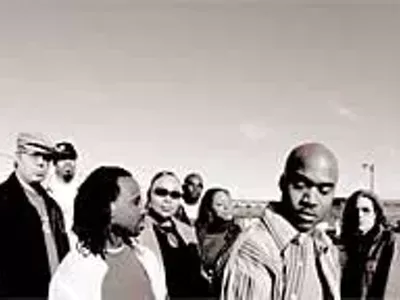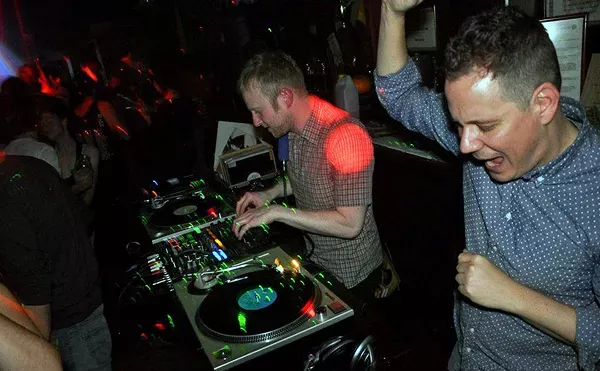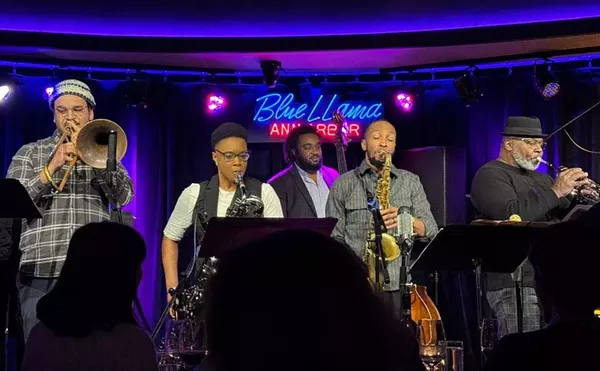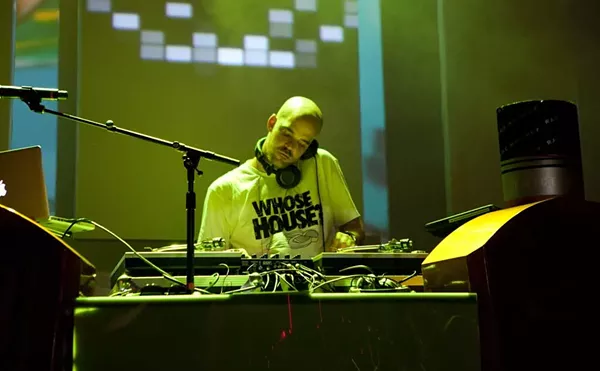With the 2004 MC5 documentary film A True Testimonial apparently shelved permanently — it was withdrawn last year by its distributor, RCA Victor Group/BMG and there are currently no plans for its release — fans still seeking to scratch their archival 5 itch can raise a toast to a newly excavated MC5 DVD. Kick Out The Jams (Creem/Music Video Distributors), a 35 minute film by the band’s old photographer Leni Sinclair (ex-wife of 5 manager John Sinclair) and Destroy All Monster’s Cary Loren, comprises footage of the band — onstage at the Grande Ballroom, at Belle Isle and other locations — originally shot by Sinclair circa 1967-69. Loren took the footage and edited it, adding myriad psychedelic effects and, as the original 8 millimeter films didn’t have sound, synching in live audio of the band.
Much of the DVD is electrifying, capturing the 5 in full extemporaneous flight, such as the sax-and-guitars freakout sequence in "Starship" and the famous promo clip for "Kick Out The Jams." It’s striking, even by today’s punk and metal standards, how absolutely hot-wired the band was in concert, a nonstop blur of motion; vocalist Rob Tyner in particular is a strutting, howling, ass-shaking, Afro-topped fury. For all those who weren’t around to witness the group in its prime, the film will be a revelation; for those who were there, it’ll serve as a primo flashback du jour.
There are also passages both pointed and poignant. During "Motor City Is Burning," juxtaposed with concert footage are images of a decaying Detroit (bonfires, liquor stores, a building being demolished), while "Come Together" includes shots of placard-wielding anti-war protesters marching down Detroit avenues. And the closing segment for "Shakin’ Street" features what appears to be backstage or after-show scenes during which Sinclair’s camera lingers, unintentionally, on first Rob Tyner then Fred Smith — the future fallen members of the MC5. Included as DVD bonus material is a 2003 interview with John Sinclair, who holds forth on the colorful life and tumultuous times of the 5. Creem editor (and Metro Times contributor) Brian J. Bowe penned incisive liner notes for the booklet. We asked Leni Sinclair a few questions about the film.
METRO TIMES: First of all, tell me how this DVD project came about.
LENI SINCLAIR: Well, I hoped to see the fruits of some of my labors before I die! I didn’t really have time to make the movie that I wanted to make, which would blow some minds. But in the meantime, I have to go along with what other people are helping me with. And it came about due to extreme poverty on my part [laughs] and knowing that I’m sitting on a gold mine — but who’s going to help me mine it? I’m like a third world country that’s sitting on diamonds and doesn’t know how to extract them from the earth!
Anyway, I had this footage that I shot when I was still in college. 8 millimeter – it wasn’t even Super 8. I bought a used 8 millimeter camera because I was taking a class in film production, in filmmaking at Wayne State University. One of my class projects was going to be the MC5; I was going to make a film of them for the project. This was right around the time when I met John. When I got pregnant, well — the rest is history. I dropped out of college.
I moved to New Orleans in ’95. I discovered this 8mm film I had stored away and I thought it was original footage. On a trip to Detroit I showed it to Cary Loren who, thankfully, got it transferred to VHS so we could see what it was.
MT: Had you forgotten about this film?
Sinclair: It was in a box, but I didn’t have a projector so I didn’t really know what it was. The film I had used mostly was Kodak 64, an amazingly stable film stock. No fading in 40 years. It was always kept with my other stuff, and I moved about 27 times so it was dragged along every time I moved. Now it’s in storage under climate-controlled conditions.
MT: Some of your footage turn up in the MC5 – A True Testimonial film as well, right?
Sinclair: Yes, some of it because I [loaned filmmakers Future Now] all my footage so they could make Beta copies of it. So Cary said let’s put some of this out, let’s put some music behind it, and just put out a rough version for all those MC5 fans who have been clamoring to see a movie about the band for years. We did this in ’98, I think. I only edited the first part of it — "Rambling Rose," and of course "Kick Out The Jams," from 1968 [originally shot by Leni and directed by then-husband John Sinclair as a promo clip for the Kick Out The Jams LP]. The rest of it was more or less Cary Loren’s artwork, his psychedelic collages using my footage of the light shows, which he did some fantastic things with. I left that pretty much up to him because I had family to take care of in New Orleans.
Cary finished our film up, and then he had a showing in Detroit and all hell broke loose. The people making True Testimonial did not want to see this come out before their movie did because it would take the wind out of their sails. So in order for me to cooperate with True Testimonial we held our DVD project back for a couple of years.
Then of course the war [between Wayne Kramer and Future Now] escalated, and the movie was finished but wasn’t released. It was like the Cold War, between the MC5 factions. And it keeps going on. Lately some people behind the scenes have been working to smoothe over the differences, and they got Becky Tyner and Wayne Kramer [together for discussions]. I haven’t spoken to the people in Chicago — I think they are in hiding! [laughs] I hope it can come out. Have it as one of those midnight shows in theaters and show it once a week. It could become a cult movie with the same people coming every time.
MT: Just like Rocky Horror — you could throw guitar picks at the screen at key moments. Do you have any opinion on the Kramer-Future Now standoff?
Sinclair: Well… no. Because this is a country of law, and there are laws governing everything to do with the music business, and if somebody broke the law, find out the truth and let the jury or judge decide. But before it gets to that point, if everybody’s being realistic — and you know none of us lives forever! — maybe they’ll sit down and say, "Okay, let’s compromise."
MT: Did you get paid by Future Now for any of your footage they copied?
Sinclair: They paid me upfront for the use of the footage but not a percentage or anything like that. When they sell it I’m supposed to get some money, depending on what the contract is about it coming out — in the theaters, DVD, nationwide or worldwide, etc. So I could make some money if it was doing well.
MT: Getting back to the Kick Out The Jams DVD …
Sinclair: I’ve actually had the right to put my DVD out for the last five years but I haven’t. It was only when the people from Creem interceded and smoothed the way. It’s the first time the "Kick Out The Jams" clip has had an official release although there’s a thousand bootlegs of it around! All the bootlegs I’ve seen have been of terrible quality, although maybe we originally distributed a few reels of it. We were trying at the time to get it to be shown on TV as a promo, like an ad for the band.
MT: Your clip for "Kick Out The Jams" is a classic clip, one that’s been seen many times over the years, and I’ve always wondered, why is the footage of the band sped up? Was that for effect, or? …
Sinclair: I didn’t have the camera on the right setting. I didn’t know what I was doing. That was with a camera I’d never used before. Some of it, fortunately, came out. But I had it on the wrong speed! [laughs] And you know, all this time, since 1968, I have wanted to go back into the studio and correct my mistake. And now the mistake is so iconic that I can’t even touch it! The part where [Kramer and Tyner] are dancing — it’s almost like a cartoon! They were pretty speedy onstage but not that speedy, you know?
And nowadays there’s all this digital equipment available, but back then, when we edited that clip, we had to do it with the Movieola, this big contraption that takes up the whole room. You have to put your film in, put your soundtrack in, and it’s such a tedious process. We cut the film strips up with scissors and had to glue them back together! It took two weeks to edit 3 1/2 minutes — that’s how painstaking it was. Now you could probably do it in two hours.
MT: According to the liner notes accompanying the DVD, some of the live footage elsewhere on the DVD was filmed at the Belle Isle Love-In in 1967, which of course turned into a mini-riot.
Sinclair: I can’t even remember whether I shot that footage or not. I was nine months pregnant and gave birth to my child four days later, so I don’t know. But I had that footage among mine so Cary used it. I’m not sure if someone gave it to me or not — and I don’t want to take credit either, since somebody might come forth after they’ve seen the movie and say it’s theirs.
MT: And Cary dubbed all the live audio for the film as well? Aside from an occasional jarring cut, the music was synched very well.
Sinclair: Yes, and he did a tremendous job. I’d hesitated to put it out in that form, thinking one day I’d have the money myself. But Cary has already invested nearly $10,000 in studio fees, and we couldn’t afford to recut it at this point so decided to go with calling it "a garage video" — that would make the excuses for some [rougher] takes!
MT: When you sat down and looked at your footage, after all those years, what were some of your impressions or reactions?
Sinclair: Well … [long pause] Just the feeling that this should be seen. And — I should make some money on it before I’m dead! [laughs] And it did bring back memories, but I am so stuck in the ’60s that it’s nothing. I look at my pictures, every day, that I took 40 years ago, and the movie’s just part of that. People who were active like that in the ’60s, I think we’re all stuck back then. Because nothing as exciting has happened ever since. I live with those memories every day, practically.
But [the film] is a flashback, especially the light show. I would love to re-create the Grande Ballroom light show some day. It was an artform that was not captured, not like making a record or something. While the artists are still alive, the people who created that artform, we should try to teach it to some next generation, you know? The lights they have now, they’re all fluff. I went to the techno festival one year, they had all the screens and a light show to go along with their productions, and I just had this overwhelming feeling: "These guys need us! If we could just get together and do a real light show with their music, the music would sound much better." It’s almost subliminal when you have a light show with the band; the music just becomes part of the whole feeling of being there because you get distracted by the lights.
MT: Do you recall the first time you encountered the MC5?
Sinclair: Oh, when I pulled the plug on them! It was the Festival Of People, August 1966, that the Artists Workshop had organized to welcome John back into the community, the day after he got out of DeHoCo, the Detroit House of Corrections. We had this whole lineup of musicians, jazz bands, poetry readings all day long. And so at the end of the night this loud rock ’n’ roll band started playing. To this day I have not found out who invited them to play at that affair.
I was prejudiced against them already from just having seen their flyers saying "MC5." I didn’t know who they were but I was prejudiced because I thought it was a slap in the face to our DC5, the jazz band Detroit Contemporary Five. I thought, "Here come these young whippersnappers saying ‘jazz is dead,’ playing rock ’n’ roll and everything!" So I’d never seen them play, didn’t know who they were. I just disliked them from their name! [laughs] And so because at the house for the festival, because I was supposed to be in charge of the place, I pulled the plug. Because it was the day after John got out of jail, we were so totally paranoid that the neighbors would call the police and take John right back! The MC5 were mad at me for a year!
MT: The start of a beautiful relationship.
Sinclair: Oh, it was!
MT: Have you seen the new David A. Carson book about the Detroit rock scene, Grit, Noise And Revolution?
Sinclair: I just got my copy. I’ve got it by my bed and can’t wait to read it. There’s all kinds of stuff in there I want to read about. That guy did a tremendous job of interviewing people, making friends with people and getting all that out of them.
I should also tell you I’m supposed to be getting together with a filmmaker about another project. I had this footage of Iggy and the Stooges performing, and he edited sound to my footage and sold it to the BBC for their "History Of Rock ’n’ Roll." And I also had all this footage of the Detroit Rock ’n’ Roll Revival, in 1969. We’re going to be looking at it to see if we can make a documentary, like a snapshot, of the rock ‘n’ roll scene here in 1969. There’s the Stooges, the MC5, Cub Koda, Mitch Ryder, the Savage Grace, the Third Power and others — all these bands that used to be around, and I have them all from ’69. It was shot without sound, but all these people had records out, so the main problem that I can foresee would be to clear the rights to the music from all these record companies that have gone out of business, to track them all down. But I think we can do that.
MT: This would practically be the audio version of Grit, Noise And Revolution…
Sinclair: Yes! And I just want people to see these guys – some of them are senior citizens now, you know? And they’ve never seen this stuff. It might be the only footage of them ever playing together.
The Kick Out The Jams free film screening is Monday, July 11, at the Magic Stick (4120 Woodward, Detroit; 313-833-9700). It’s followed by a Q&A session with filmmakers Cary Loren and Leni Sinclair. WABX DJ Jerry Lubin and Creem’s Brian J. Bowe host.
Fred Mills is a freelance writer. Send comments to [email protected]





